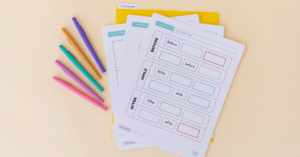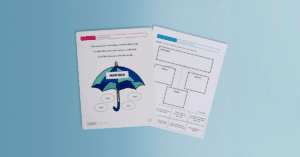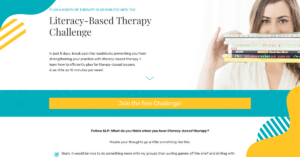Listen on Apple Podcasts Listen on Spotify
Welcome to the final installment of our Literacy-Based Therapy Bootcamp series.
So far we’ve covered choosing a book, pre-story knowledge/reading, post-story comprehension, and targeted skill activities.
Today we’re going to talk about parallel stories — which just might be Marisha’s favorite part of the whole literacy-based therapy framework.
The sprinkles on this literacy-based cupcake is the fact that Marisha isn’t the only one who likes this step. Her students really enjoy parallel stories too!
She has had multiple experiences of working with students who were a little bit resistant to participating in therapy because it can be hard! Working on skills that are challenging can feel discouraging at times.
But once her students were able to create their own stories — and final products related to those stories — they started having fun with the activities and were hooked!
Parallel stories are an incredible way to integrate all of the skills that we’ve targeted throughout our literacy-based units.
The goal of this activity is to pull the vocabulary, sentence structures, and plot elements from the story you’ve been using for the unit, and then use them to create something new.
This is a lot like story generation, but we have a jumping off point to draw inspiration from thanks to the previous story. We can use those building blocks to integrate the skills that we’ve targeted in a fresh — and fun — way.
One of Marisha’s favorite visuals to use for parallel stories is a graphic organizer because it’s super helpful for piecing together the story grammar elements:

Visuals like this give students a framework to follow, so that language learning tasks are less demanding, more meaningful, and more authentic.
The end result is that students’ comprehension improves because they can make more sense of the information they’re taking in.
When they start to gain confidence with the framework and generate their own stories, you can choose to put the organizer away, or keep it out for easy reference; it’s about using your clinical judgment and finding that sweet spot of support, depending on the students’ needs.
🎧 In this episode of the SLP Now podcast, Marisha walks listeners through an example of a parallel story. She uses the story “Snowman at Night” as an example, but replaces the snowmen with cacti. Listen in to get all the details!
When retelling the story, we get to use our grammar, vocabulary, and complex syntax — we’re pulling in all of those targets, and doing it in a meaningful way.
With parallel stories we get to take this one step further, and get even more meaningful practice because of the additional student buy-in; they love it! Plus, you can extend the activity (and increase the fun!) beyond filling in a graphic organizer.
While working on the parallel story, we can create an actual product to tell the story — whether it’s a miniature book or a slide show on the computer.
For some students, you can take some pieces of paper, fold them over into a book, and then transcribe the notes from the graphic organizer and put them into text format. When that’s complete, they can take a little bit of time to illustrate the book.
Remember: the point isn’t to spend a ton of time drawing unless it works out with the overall framework of the group and the sessions… but this is not art class. It may be easier and quicker to pull up images that you can print and glue — do whatever is simplest!
The goal is to spend time talking and using language, not master our drawing skills. 😅
Of course, there are some alternative options because writing can be a big barrier. You can switch it up and have students create a video! Have them tell you the story so you can transcribe it, and then reenact the story — and record it — so that they have a “movie” to share at the end.
No matter which activity we do, the goal for this activity is to create something that the student can take away from their session, and share.
The most meaningful practice they can get happens outside of the speech room, and in the context of their real lives. Our job is to help them develop their language skills — so they can tell (and retell!) a story they’re proud of.
And that’s a wrap in the Literacy-Based Bootcamp series here on the podcast! Stay tuned for next week’s episode, when we chat about how to build your paperwork system. 💪
Links and Additional Resources
#174: Literacy-Based Therapy Bootcamp: How to Pick a Book
#175: Literacy-Based Therapy Bootcamp: Step 1 (Pre-Story Knowledge) and Step 2 (Reading)
#176: Literacy-Based Therapy Bootcamp: Step 3 (Post-Story Comprehension)
#177: Literacy-Based Therapy Bootcamp: Step 4 (Focused Skill Activities)
SLP Now Trial (Your first 5 downloads are free! Grab your Narrative Visuals today!)
Subscribe
Subscribe to the SLP Now podcast and stay tuned for our next series. We’re kicking off September by helping you get your data collection, paperwork, and therapy planning processes in tip-top shape! 💪
Listen to The SLP Now Podcast on Apple ★ Spotify ★ Google ★ Stitcher ★ Castbox or wherever you listen to podcasts.
Transcript
Marisha
00:00
Hello there, and welcome to the SLP now podcast, where we share practical therapy tips and ideas for busy speech language pathologists. Grab your favorite beverage and sit back as we dive into this week's episode.
Marisha
00:19
Hey there. Welcome to day five of the literacy based therapy challenge. And this is a little bit of a sad day because it means the challenge is starting to wrap up. But I really think that parallel stories are one of my favorite parts of the unit. Students absolutely love them. They've made a huge difference. I can think of several students who were just a little bit resistant to participating in therapy because it was a little hard for them. They were working on skills that they knew were challenging, but once they got to create their own stories and create final products related to their stories, they were hooked. And they have a lot of fun with these activities, and I do, too. And it's also just a really incredible way to integrate all of the skills that we've targeted throughout the unit.
Marisha
01:09
It is pretty incredible. Super powerful. I love it. So I'll tell you what a parallel story is. The goal of this activity is to pull the vocabulary, the sentence structures, the plot elements, and pull that from the story and then create something new. So it is basically like story generation, but we have a jumping off point. So we have the previous story, we get some inspiration from that, and then we integrate, like I said, the skills that we've targeted. So what I really like to do is I like to use the story grammar organizer that we've used throughout the framework, and we'll pull up the one that we created for the actual story. So, for example, if we're doing snowmen at night, we would fill in the characters and all of that from snowmen at night.
Marisha
01:58
Then we would take another graphic organizer and pull what we did with. Maybe we would create our own idea. So, I'm in Arizona. We have a lot of cacti. So maybe we would do a story about cacti at night. So we would look at this graphic organizer for snowmen at night, and we would kind of pull over the elements so the character would be different. So instead of snowmen, we have cacti, and then the setting would be different. Well, different, but not. So instead of in the snow at night, it would be in the desert at night. And then we would just keep going through and see, okay, this is what the story had, and pull over what makes sense, and then just make adjustments based on what doesn't fit for the specific character.
Marisha
02:44
But this is just a really cool way to integrate all of those different skills. So when were retelling the actual story, were using our grammar, vocabulary, all of our complex syntax, all of that good stuff. We're pulling in all of those targets, and were doing that in a very meaningful way. But this gets to take it one step further. We get more meaningful practice, and with the student buy in, they love it. So some ideas for things that I like to do to extend this. So after we fill in the graphic organizer, they have to do that work first. Then we can write the story or retell the story.
Marisha
03:25
So for some students, I just take some pieces of paper, fold them over into a book, and we'll transcribe or move over our notes from the graphic organizer and put it into text format, and then they can take a little bit of time to illustrate the book. And we do not spend a ton of time on drawing unless it ends up working out with just the overall framework of the group and the sessions. But it's not art class for the most part. So maybe we'll just pull images and print them and glue them on whatever is quick and easy in terms of that part, I want to spend our time talking and using language and not being artists necessarily, so that's what we do. But there are some other alternative options.
Marisha
04:09
So writing can be a big barrier, and it's a great activity to support. But sometimes I like to switch it up and have students create a video. So I might have them tell me the sentences of the story, and I might transcribe it for them or whatnot. But then we'll focus on using our language in creating a video kind of activity where we reenact the story, and that's a lot of fun, and students love getting to share that. And then the best part of the unit is just being able to take that final product, whether it's a book, a digital book, a printed book, a video, animation, I'll share some links to my favorite resources in the comments.
Marisha
04:51
But no matter what we do, the goal is for this to be something that the student can take home, that they can share in the classroom or with their parents, with their friends, and continue to practice their language skills and being able to retell a story that they're very proud of. So that wraps up our unit, and we'll have a little bit of follow up resources coming your way. But thank you guys so much for joining us for this challenge. I hope it was super helpful, and we'll see you soon.
Marisha
05:22
Thanks for listening to the SLP now podcast. If you enjoyed this episode, please share with your SLP friends. And don't forget to subscribe to the podcast to get the latest episodes sent directly to you.
Marisha
05:34
See you next time.
Sign up to receive email updates
Enter your name and email address below and I'll send you periodic updates about the podcast.




Reader Interactions